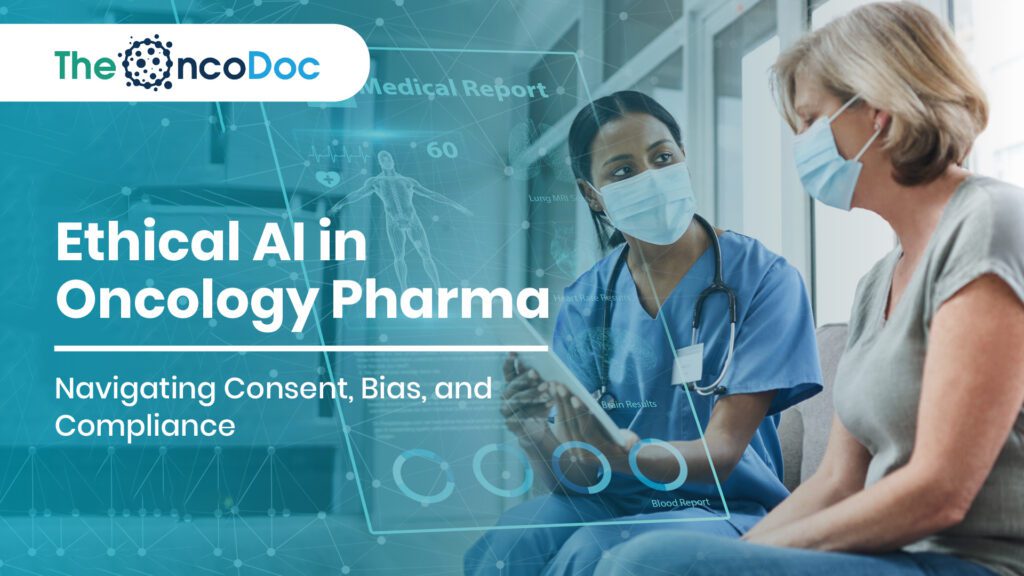Introduction: The Promise and Peril of AI in Oncology Marketing
Artificial Intelligence (AI) is reshaping how pharmaceutical companies operate across the oncology landscape. From identifying biomarkers to personalizing HCP engagement and automating clinical trial recruitment, AI brings efficiency, scale, and intelligence to a traditionally complex space. However, with this innovation comes responsibility.
In oncology where data is sensitive, decisions are critical, and patient trust is non-negotiable, the ethical use of AI is not just a best practice; it’s a necessity.
The convergence of marketing, medicine, and machine learning introduces new challenges around consent, privacy, algorithmic bias, and regulatory compliance. Failing to address these could erode trust among oncologists, damage brand credibility, and even harm patient outcomes.
This article explores how oncology-focused pharma marketers and developers can build ethical AI frameworks that prioritize transparency, mitigate bias, and operate within the boundaries of global regulations. It’s not just about what AI can do, but what it should do.
Artificial Intelligence (AI) has rapidly transitioned from a buzzword to a backbone technology in modern healthcare. Nowhere is its impact more profound or more sensitive than in oncology. With cancer care becoming increasingly personalized, AI has emerged as a powerful tool to support clinical decisions, streamline drug development, and transform how pharmaceutical companies engage with healthcare professionals (HCPs) and patients.
In oncology marketing, AI promises to revolutionize communication by enabling personalized, timely, and data-driven interactions. From recommending scientific content to oncologists based on their recent research interests to delivering patient education tools that reflect a user’s language and emotional state, AI is helping the industry move from broad outreach to individualized, meaningful engagement. At its best, AI enables smarter segmentation, stronger relationships, and faster access to potentially life-saving therapies.
Yet alongside this promise lies a complex set of challenges. As AI systems rely on massive volumes of sensitive health data, concerns around privacy, consent, bias, and regulatory compliance come into sharp focus. In the high-stakes world of cancer care, any misuse or misinterpretation of data, whether intentional or algorithmic, can undermine trust, widen disparities, and compromise patient outcomes.
The ethical implications of AI in oncology marketing are not theoretical, they are real, urgent, and growing. How can pharma companies ensure transparency in AI-driven targeting? Are patients and physicians truly aware of how their data is being used? And how can we prevent AI from reinforcing existing biases in healthcare access and treatment?
This article addresses these critical questions. It explores how AI can be used responsibly in oncology marketing by establishing ethical guardrails, aligning with legal standards, and prioritizing human-centered design. As we embrace innovation, we must also ensure that integrity, fairness, and accountability are embedded into every algorithm we deploy.
1. Understanding the Ethical Landscape of AI in Oncology
Artificial intelligence is transforming oncology, from research and diagnostics to treatment planning and communication. In the marketing arm of oncology pharmaceuticals, AI is often used to segment audiences, personalize content, and automate interactions. While these advancements bring efficiency and scale, they also introduce complex ethical dilemmas that the industry can no longer afford to overlook.
The ethical landscape of AI in oncology is shaped by the sensitivity of the data it handles and the life-altering decisions it may influence. Unlike general healthcare data, oncology-related information often includes genetic profiles, treatment responses, biomarker statuses, and deeply personal health narratives. Misusing or misrepresenting this data, even unintentionally, can have serious consequences, including mistrust, misinformation, and health disparities.
Three foundational pillars define the ethical responsibilities of AI use in oncology:
- Consent: Patients and healthcare professionals must have full transparency and control over how their data is collected, stored, and used. Consent must be ongoing, granular, and purpose-specific, especially when data is used beyond clinical care for marketing or engagement.
- Bias: AI algorithms are only as fair as the data used to train them. If historical data contains imbalances, such as underrepresentation of rural clinicians or patients from minority groups, those biases can be replicated and even magnified by AI models. This can result in uneven access to resources, educational content, or clinical support.
- Compliance: With AI’s global deployment, adherence to regional and international data protection laws is vital. This includes the GDPR in Europe, HIPAA in the United States, and India’s Data Protection Act, among others. AI tools must be auditable, explainable, and fully compliant with evolving legal frameworks to ensure safe and lawful implementation.
Ethics in AI isn’t just about checking boxes; it’s about building systems that are respectful, fair, and transparent from the ground up. In oncology, where the emotional, clinical, and social stakes are so high, ethical oversight must be woven into every stage of AI development and deployment.
Understanding these ethical dimensions isn’t a barrier to innovation; it’s the foundation for sustainable, responsible progress. As AI continues to reshape oncology marketing, grounding our strategies in ethics ensures that we’re not only reaching more people but also doing so with integrity.
2. Consent: Beyond Checkboxes to True Transparency
Consent in the age of AI goes beyond a one-time “accept” button on a website. It involves informed, ongoing, and specific permission for data to be used, not just collected.
In oncology, where data often includes genomic profiles, clinical outcomes, and personal treatment preferences, transparency is critical.
Pharma companies using AI must ensure the following:
- Granular consent: Users should know what kind of data is being collected (e.g., behavior, EMR patterns, search queries).
- Purpose-specific authorization: Data used for marketing personalization should not be repurposed for clinical predictions without additional consent.
- Easy opt-outs: Users should be able to withdraw consent at any time without penalty.
Modern consent frameworks must be embedded within digital touchpoints, allowing users to update preferences as technology, and their comfort level, evolves.
Interpretation: Physicians expect clarity, control, and accountability when AI tools influence clinical or marketing decisions.
3. Bias: The Hidden Threat in Oncology AI
Bias in AI is rarely intentional, but it is pervasive, particularly in healthcare.
Training an algorithm on historical prescribing data, for example, can reinforce outdated or inequitable treatment patterns. A chatbot trained only on Western oncology terminology may misinterpret questions from physicians in Asia or Africa.
Bias can enter AI systems through:
- Data imbalance – Overrepresentation of one demographic group
- Labeling errors – Human inaccuracies in classifying training data
- Design bias – Unconscious assumptions made during model development
In oncology, bias can skew how marketing messages are personalized. For example, if AI is trained predominantly on male oncologist behavior, it may unintentionally deprioritize engagement strategies for female oncologists or those practicing in rural areas.
To mitigate this:
- Use diverse datasets from varied geographies, demographics, and practice settings.
- Continuously audit AI outputs for unintended patterns.
- Involve interdisciplinary teams (clinicians, data scientists, and ethicists) in model development and validation.
Interpretation: Bias and consent are viewed as the most pressing ethical risks by healthcare professionals using AI-driven pharma tools.
4. Compliance: Navigating a Complex Global Framework
Compliance in AI doesn’t stop at HIPAA or GDPR. Oncology marketing, especially when it spans across borders, must adhere to a web of regional and industry-specific regulations.
Some key frameworks include:
- GDPR (Europe) – Focused on data protection, consent, and portability
- HIPAA (USA) – Protects personal health information
- DPDP Act (India, 2023) – Addresses sensitive personal data usage
- ICH GCP and FDA guidance – Relevant when AI is used in drug development or patient-facing tools
For AI systems, compliance means:
- Documenting data sources and usage permissions
- Maintaining audit trails for algorithmic decisions
- Offering transparency reports on AI-driven personalization
- Using explainable AI (XAI) for models impacting treatment decisions
Interpretation: While most companies track data sources, many lack region-specific compliance protocols and structured ethical audits.
5. Explainable AI (XAI): Making the Black Box Transparent
One of the most common criticisms of AI is its opacity. Oncologists, marketers, and regulators alike often refer to algorithms as “black boxes” they know what goes in and what comes out, but not how decisions are made.
Explainable AI (XAI) aims to solve this by making machine learning decisions understandable and auditable. In pharma marketing, this might include:
- Showing why a certain piece of content was recommended to a specific oncologist
- Identifying which data points influenced segmentation or targeting
- Offering confidence scores on AI-driven recommendations
Providing this transparency fosters trust among users and demonstrates ethical intent.
6. Human Oversight and Ethical Review Boards
AI should augment, not replace, human judgment. In oncology, especially, where emotions, ethics, and uncertainty are intertwined, human oversight remains essential.
Pharma companies are now forming AI ethics committees to:
- Approve high-risk algorithms
- Review model outputs for ethical integrity
- Investigate reported concerns from HCPs or patients
- Ensure alignment with internal compliance teams and legal frameworks
The presence of such boards reflects a maturity in how organizations approach AI—not just as a technical tool, but as a stakeholder in the healthcare process.
7. Patient Perspective: Personalization Without Manipulation
Patients are increasingly part of the oncology marketing ecosystem, whether through patient portals, support apps, or digital ads. AI may personalize content based on age, diagnosis, language, and even sentiment detected in chatbot conversations.
However, the ethical boundary between personalization and manipulation must be carefully observed.
Best practices include:
- Labeling sponsored or branded content clearly
- Avoiding emotionally charged messaging based on inferred distress
- Using AI to inform, not persuade, clinical decisions
Patient trust is hard-won and easily lost. Ethical AI ensures that patient-facing systems remain educational, transparent, and aligned with clinical best practices.
8. Cross-Functional Collaboration: The Ethics-Technology-Clinical Triad
Developing ethical AI in oncology pharma is not a task for the IT or marketing department alone. It requires collaboration across three core domains:
- Technology Teams – Build, validate, and update AI models
- Clinical Experts – Ensure outputs align with evidence-based care
- Ethics & Compliance Officers – Monitor risks, approvals, and consent integrity
This triad must work in tandem from the earliest planning phases to deployment, with a shared understanding that patient well-being and physician trust are paramount.
9. The Role of Third-Party AI Vendors
Many pharma companies rely on external vendors to build or operate AI platforms. This introduces new ethical questions:
- Are vendors using responsibly sourced data?
- Do they offer audit access and transparency?
- Are they familiar with healthcare compliance regulations?
Vendor partnerships should be governed by strict data use agreements, third-party audits, and shared accountability for ethical breaches.
10. Looking Ahead: A Framework for Ethical AI in Oncology
To operationalize these values, companies can build an internal Ethical AI Framework based on:
- Principle 1: Purpose – Clear definition of the AI’s intent and boundaries
- Principle 2: People – Consent, inclusivity, and non-discrimination
- Principle 3: Process – Explainability, auditability, and redress mechanisms
- Principle 4: Proof – Continuous monitoring, validation, and performance benchmarking
By anchoring AI development to these principles, pharma companies can innovate responsibly—without compromising ethical standards.
Conclusion: Innovation Rooted in Integrity
AI offers immense potential to transform oncology pharma, from streamlining operations to enabling life-saving personalization. But innovation without ethics is a fragile foundation.
As pharma companies increasingly rely on AI to connect with oncologists, patients, and institutions, they must prioritize transparency, fairness, and legal compliance at every step. Ethics must not be an afterthought; it must be embedded in design, deployment, and daily operation.
By doing so, the industry not only safeguards trust, it strengthens its ability to deliver meaningful impact in the lives of those facing cancer.
The Oncodoc team is a group of passionate healthcare and marketing professionals dedicated to delivering accurate, engaging, and impactful content. With expertise across medical research, digital strategy, and clinical communication, the team focuses on empowering healthcare professionals and patients alike. Through evidence-based insights and innovative storytelling, Hidoc aims to bridge the gap between medicine and digital engagement, promoting wellness and informed decision-making.



